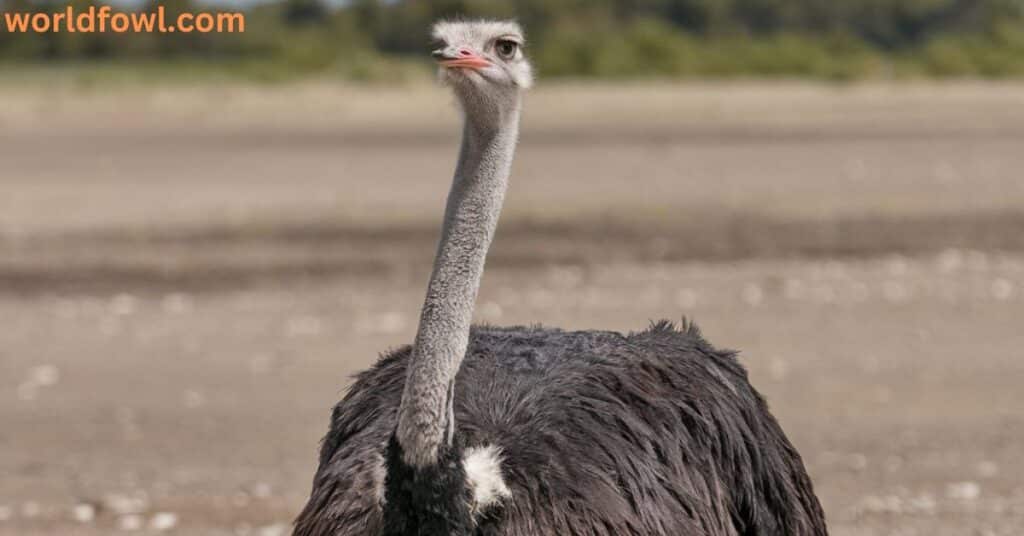Ostriches are among the most fascinating and awe-inspiring animals on the planet. Known for their towering height, incredible speed, and powerful legs, these birds are one of the few flightless species that can captivate our attention. But while they may seem gentle, Do Ostriches Attack Humans? And if so, why? This article will take a deep dive into ostrich behavior, the factors that can trigger an attack, and how humans can stay safe around these majestic yet unpredictable birds.
Who Are Ostriches?

Before we can discuss whether ostriches attack humans, it’s essential to understand what makes these birds so unique and why they behave the way they do. Ostriches, scientifically known as Struthio camelus, are the largest and heaviest living birds on Earth. Their physical size and strength are remarkable, and their behavior reflects their evolutionary adaptations to survive in the harsh, open landscapes of sub-Saharan Africa and parts of the Middle East.
Ostriches are flightless birds, meaning they cannot take to the skies like other birds. Instead, they have evolved with adaptations that help them survive in their land-based environment. From their muscular legs to their sharp claws, everything about an ostrich’s anatomy is designed to support running at high speeds, defending themselves against predators, and protecting their territory.
Physical Characteristics
Ostriches are known for their sheer size and strength:
- Size: Adult male ostriches stand between 8 to 9 feet tall and can weigh anywhere between 220 to 350 pounds. Female ostriches are typically smaller, averaging about 6 to 7 feet in height and weighing up to 290 pounds. Their towering height makes them easy to spot in their natural habitats.
- Speed: One of the most impressive traits of an ostrich is its speed. Ostriches can run up to 45 mph, making them one of the fastest animals on land. Their long, powerful legs are built for sprinting, and they use this ability to escape predators, such as lions, hyenas, and even humans.
- Legs and Claws: An ostrich’s legs are a critical part of its defense mechanism. With two toes on each foot, the outer toe bears a large, sharp claw capable of delivering a powerful kick. This is an important tool for both running and defending the bird from threats.
Habitat and Distribution
Ostriches are native to sub-Saharan Africa, where they can be found in arid and semi-arid regions like the savannahs and deserts. These open, grassland areas allow ostriches to use their speed and keen eyesight to detect predators from afar. Their habitat often consists of sparse vegetation, which provides little cover but ample visibility to spot approaching threats.
While ostrich farms have spread the bird to other parts of the world, including Australia and North America, ostriches in the wild remain concentrated in Africa. They have adapted to a variety of environments, including the harsh, dry landscapes of the Kalahari Desert and the more temperate regions of East Africa. In areas where food is scarce, ostriches may rely on the moisture from the plants they consume, helping them survive in desert conditions.
Ostriches are also known for their adaptability. They can endure extreme heat and long periods without water, and their diet mainly consists of plant matter such as grasses, leaves, and seeds. Their adaptability also extends to their behavior, which can change based on the season, available resources, and presence of threats.
See Also : Do Voles Attack Humans? Clarifying the Risks!
Ostrich Behavior: Understanding These Majestic Birds

Ostriches are fascinating creatures with complex behavior. While they may seem docile and calm most of the time, their instincts can take over in certain situations. Understanding ostrich behavior is key to knowing why they may attack humans and how to avoid such encounters.
General Temperament
In general, ostriches are not aggressive animals by nature. They are herbivores, feeding on grasses, seeds, and shrubs. Their primary instinct is to survive, and they generally prefer to avoid confrontation whenever possible. Unlike other birds, they do not flock together for protection against predators, as they are highly capable of running away from danger. Ostriches rely on their excellent eyesight and swift running ability to escape most threats.
However, ostriches are also territorial and protective animals, particularly when it comes to their nests and young. If an ostrich feels threatened, especially during the breeding season or when its nest is endangered, it can quickly become aggressive. An ostrich’s aggression may not always be immediately apparent, but there are clear signs of when these birds may feel provoked or scared.
Breeding Season Aggression
The breeding season is one of the most important times in an ostrich’s life cycle, and it is also the time when they are most likely to exhibit aggressive behavior. During this period, male ostriches are particularly territorial. They establish a nesting area, often selecting a space that they will fiercely defend from both other males and potential threats. The males will go to great lengths to protect their mate and their territory. They may engage in dramatic courtship displays, such as puffing out their feathers, stomping their feet, and making loud calls to assert dominance.
In some cases, the male ostriches will become very aggressive if they feel their nesting area is being invaded, either by other males or humans. A defensive ostrich kick can result in serious injuries to anyone who gets too close to the nest or the bird itself. These attacks typically occur when a human unknowingly or unintentionally intrudes into the bird’s nesting area.
During nesting, females can also become aggressive, particularly if they feel their eggs are at risk. Both males and females will fiercely defend their nests and territory against perceived threats, whether those threats come from other animals or humans.
Social Dynamics and Flock Behavior
Although ostriches are territorial, they are also social birds. In the wild, ostriches form loose flocks of up to 50 birds, typically consisting of females, males, and their offspring. Within the flock, a clear social hierarchy is established, with dominant males usually protecting the group.
The ostrich’s behavior within the flock is generally peaceful. They work together to watch out for predators, communicating through vocalizations and body language. If a predator is spotted, the flock will often scatter and seek cover, relying on their speed and visibility to evade danger. It is during these moments of heightened awareness that ostriches may show signs of anxiety or stress, signaling that they are preparing to flee.
However, social dynamics can change when resources are scarce. In these situations, ostriches may become more aggressive toward one another, especially if food or water is limited. The presence of predators can also change flock behavior, leading to more defensive posturing and protective actions from dominant individuals.
Ostriches in Captivity: Ostrich Farms and Human Interaction
In ostrich farms, human-ostrich interactions are far more common. These farms raise ostriches for various purposes, including the production of ostrich leather, feathers, and eggs. While ostriches are generally accustomed to human presence, they can still become aggressive if they feel threatened, cornered, or provoked.
Farm workers and visitors are often trained to handle ostriches with care, respecting their space and avoiding sudden movements. Ostrich farms often take measures to prevent aggression, such as providing the birds with enough space to roam and minimizing stress-inducing activities. However, despite these precautions, ostriches on farms may still show aggression if they are startled or feel their territory is being invaded.
See Also : Will Crows Attack Humans? The Hidden Dangers!
Reasons for Ostrich Attacks: What Triggers Aggression?

There are several reasons why an ostrich might attack a human. In most cases, these attacks are not premeditated but are the result of the bird feeling threatened. Understanding these triggers is key to preventing an encounter from escalating into aggression.
Territorial Instincts
One of the main reasons for an ostrich to become aggressive is its territorial instincts. As previously mentioned, ostriches can become highly protective of their nesting areas during the breeding season. If they feel that their territory is being encroached upon, they may see it as a threat and will defend it by any means necessary.
Males, especially, are quick to exhibit aggression toward other males who try to challenge their dominance. Similarly, ostriches may also become aggressive if they feel a human is too close to their nest. This behavior is often seen in both wild ostriches and those kept in ostrich farms.
Perceived Threats
Another major trigger for ostrich aggression is a perceived threat. Ostriches are naturally cautious birds that rely heavily on their sense of sight to detect danger. If an ostrich perceives a human or animal as a potential threat, it will not hesitate to act in self-defense.
This defensive behavior can include:
- Aggressive posturing: The ostrich may puff out its feathers, raise its head high, and begin stomping its feet in an attempt to intimidate the perceived threat.
- Kicking: If the perceived threat does not back down, the ostrich may deliver a powerful kick with its strong legs. Ostrich kicks can be deadly and are the primary means of defense.
Stress and Anxiety
Ostriches, like many animals, can become stressed if they feel cornered or trapped. Stress may be caused by a variety of factors, such as the presence of predators, lack of food, or excessive human interaction. When ostriches are stressed, they are more likely to exhibit aggressive behaviors as a means of protecting themselves.
Stress-induced aggression is particularly common in ostriches that are confined to smaller spaces or those that have limited access to food and water. In these situations, ostriches may lash out at anyone who gets too close, perceiving them as a threat to their well-being.
See Also : Do Horses Attack Humans? Horse Behavior
How Dangerous Are Ostrich Attacks?

While ostriches generally avoid conflict, ostrich attacks can be incredibly dangerous when they do occur. The strength and power behind an ostrich’s legs can cause serious injury or even death. Let’s break down the potential for injury and fatality risk.
Potential for Injury
Ostrich kicks are the primary weapon in their defensive arsenal. A single well-placed kick can cause severe damage to a human’s body, especially if it targets the chest or abdomen. The powerful legs of an ostrich allow them to strike with immense force, and their sharp claws can tear through flesh.
Common injuries from ostrich attacks include:
- Broken bones
- Internal organ damage
- Deep cuts and lacerations
- Concussions from being knocked to the ground
While ostrich attacks are rare, they can result in life-threatening injuries, particularly if a person is unable to escape the bird’s reach quickly.
Fatality Risk
Although fatal attacks are extremely rare, they are possible. The combination of a powerful kick, sharp claws, and the bird’s size can be deadly, especially if the victim is in a vulnerable position or unable to defend themselves. In fact, there have been recorded instances of humans dying after being attacked by an ostrich.
In most cases, these fatalities occur when the victim is in close proximity to the bird, such as during an attempt to feed or interact with it in captivity. However, even in wild settings, ostriches can become aggressive if they feel their space is being invaded. { Do Ostriches Attack Humans }
Prevention and Safety Measures: How to Stay Safe
Although ostrich attacks are rare, it is important to take precautions when around these powerful birds. Whether you’re visiting an ostrich farm, hiking in their natural habitat, or encountering them in the wild, knowing how to protect yourself can reduce the risk of injury.
Keep Your Distance
The most important safety rule when dealing with ostriches is to keep your distance. Never approach an ostrich too closely, especially if it seems agitated or is in a defensive posture. In general, maintain at least 10 to 15 feet of space between you and the bird to avoid triggering an aggressive response.
Watch for Warning Signs
Ostriches will often give warning signs before becoming aggressive. These can include:
- Puffing out feathers
- Stomping their feet
- Raising their heads high
- Moving in a defensive manner
If you see these signs, back away slowly and give the bird space. Avoid making sudden movements that could be perceived as threatening. { Do Ostriches Attack Humans }
Respect the Bird’s Territory
During the breeding season, ostriches can become particularly aggressive. Always be aware of your surroundings and avoid getting too close to an ostrich’s nest or territory. If you encounter an ostrich in the wild, move away quietly and give it plenty of space.
Wear Protective Gear
If you are working with ostriches in a farm or agricultural setting, consider wearing protective gear like sturdy boots, gloves, and long pants to minimize the risk of injury. This will protect you from potential kicks or scratches.
What to Do if Attacked
If you are attacked by an ostrich, it is important to remain calm. Here’s what you can do to protect yourself:
- Protect your vital organs: Try to shield your chest and abdomen, which are the most vulnerable areas.
- Seek cover: Move behind a tree, vehicle, or other barrier that can shield you from the ostrich.
- Do not fight back: It is difficult to outpace or overpower an ostrich. Instead, focus on escaping the situation safely.
See Also : Are Deer A Sign Of Angels?
FAQs: Do Ostriches Attack Humans
Are Ostriches Always Aggressive?
No, ostriches are not naturally aggressive. They generally prefer to avoid conflict and will only attack if they feel threatened, especially if they are protecting their nest or territory.
Can Ostriches Be Tamed?
While ostriches can become accustomed to human presence, they cannot truly be tamed. Their wild instincts, especially their territorial instincts and protective behaviors, make them unpredictable at times.
How Fast Can Ostriches Run?
Ostriches are incredibly fast, reaching speeds up to 45 mph. This speed is a vital defense mechanism, helping them escape predators and, in some cases, avoid human encroachment.
Can Ostriches Kill Humans?
While fatal attacks are rare, it’s possible for an ostrich to cause serious injury or death. Their powerful legs and sharp claws are capable of causing severe harm if they feel threatened.
How Do Ostriches Defend Themselves?
Ostriches rely on their strong legs and powerful kicks for defense. They may also use their sharp claws to slash at predators. Their long necks and keen eyesight allow them to spot threats early.
Conclusion: Do Ostriches Attack Humans
In conclusion, while ostriches are not naturally aggressive animals, they can and will attack humans if they feel threatened. The main reasons for these attacks are territorial defense, perceived threats, and stress-induced aggression. Understanding these triggers and respecting ostriches’ natural behavior can help minimize the risk of dangerous encounters.
Ostriches are incredible creatures, but like all wild animals, they should be treated with caution and respect. By maintaining a safe distance, observing their body language, and following safety protocols, humans can coexist with these magnificent birds without unnecessary conflict. { Do Ostriches Attack Humans }

Henry James is a seasoned blogger and a passionate storyteller on “World Fowl.” With years of experience crafting engaging content, he brings a unique blend of expertise and creativity to his writing. Henry specializes in exploring diverse topics with depth and clarity, captivating readers worldwide.







